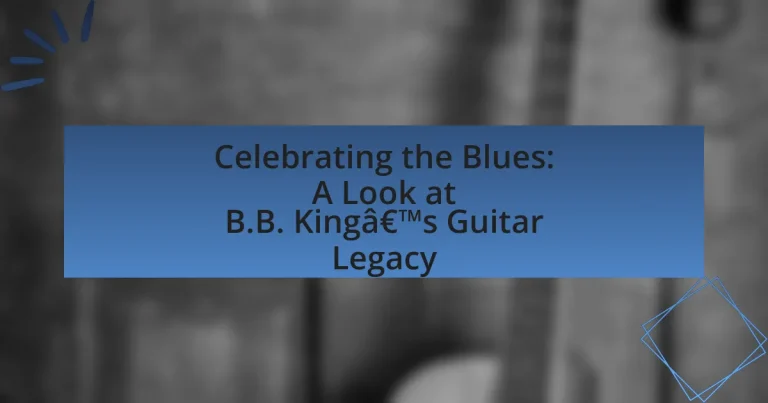B.B. King is a pivotal figure in the blues genre, renowned for his distinctive guitar playing style characterized by expressive string bending and vibrato. His signature guitar, Lucille, symbolizes his artistic influence and has inspired countless musicians. The article explores King’s unique techniques, his evolution as an artist, and the significant impact he had on blues music and contemporary guitarists. It also highlights his numerous accolades, including 15 Grammy Awards and his induction into the Rock and Roll Hall of Fame, underscoring his lasting legacy in American music history. Additionally, the article discusses how aspiring musicians can learn from King’s approach to emotional expression and guitar techniques.

What is B.B. King’s Guitar Legacy?
B.B. King’s guitar legacy is defined by his unique style of blues guitar playing, characterized by expressive string bending and vibrato. His signature guitar, Lucille, became an iconic symbol of his artistry and influence in the music world. King’s technique, which combined elements of jazz and blues, has inspired countless musicians and shaped the sound of modern blues. His contributions to the genre are evident in his numerous awards, including 15 Grammy Awards, and his induction into the Rock and Roll Hall of Fame in 1987, solidifying his status as a pivotal figure in American music history.
How did B.B. King influence the blues genre?
B.B. King significantly influenced the blues genre through his unique guitar playing style and emotive vocal delivery. His signature technique, characterized by expressive string bending and vibrato, set a standard for blues guitarists and inspired countless musicians across various genres. King’s use of the Gibson Lucille guitar became iconic, showcasing his ability to blend traditional blues with elements of jazz and rock, which broadened the appeal of the genre. His extensive discography, including classics like “The Thrill Is Gone,” not only solidified his status as a blues legend but also helped to popularize the genre globally, making it accessible to new audiences.
What unique techniques did B.B. King use in his guitar playing?
B.B. King utilized several unique techniques in his guitar playing, most notably his expressive string bending and vibrato. His string bending technique allowed him to create a vocal-like quality in his solos, which became a signature aspect of his sound. King often employed a slow, controlled vibrato that added emotional depth to his notes, making them resonate with listeners. Additionally, he frequently used a technique called “chicken picking,” where he plucked the strings with his fingers while muting others, creating a sharp, staccato effect. These techniques, combined with his use of a single-coil pickup and a light touch on the strings, contributed to his distinctive blues style and established him as a pivotal figure in the genre.
How did his style evolve throughout his career?
B.B. King’s style evolved significantly throughout his career, transitioning from a raw, rural blues sound to a more polished, sophisticated approach. Early in his career, King’s music was heavily influenced by the Delta blues, characterized by simple melodies and emotional storytelling. As he gained popularity, particularly in the 1950s and 1960s, he incorporated elements of jazz and swing, which added complexity to his guitar playing and vocal delivery. This evolution is evident in his signature style, known as “Lucille,” where he combined expressive string bends and vibrato with a smooth, melodic phrasing. His later works, such as “The Thrill Is Gone,” showcased a refined sound that appealed to a broader audience, blending blues with pop and R&B influences. This progression reflects his adaptability and innovation within the genre, solidifying his legacy as a pivotal figure in blues music.
What role did B.B. King’s guitar play in his music?
B.B. King’s guitar played a central role in his music by serving as the primary instrument through which he expressed his emotional depth and unique style. His guitar, famously named “Lucille,” was integral to his signature sound, characterized by expressive string bends and vibrato that conveyed a wide range of emotions. King’s innovative techniques, such as his use of the guitar to mimic the human voice, allowed him to create a powerful connection with his audience. This approach not only defined his musical identity but also influenced countless musicians in the blues genre and beyond, solidifying his legacy as a master guitarist.
What specific guitars did B.B. King favor and why?
B.B. King favored the Gibson Lucille guitar, which he designed in collaboration with Gibson. He chose this model for its unique features, including its lack of f-holes, which reduced feedback during performances, and its lightweight body, allowing for easier playability. The Lucille also provided a rich, warm tone that complemented King’s expressive playing style, making it ideal for his signature blues sound.
How did his guitar tone contribute to his sound?
B.B. King’s guitar tone significantly contributed to his sound by utilizing a unique combination of vibrato and sustain, which created an expressive and emotive quality. His use of a Gibson Lucille guitar, paired with a specific setup that included a tube amplifier, allowed for a warm, rich tone that resonated deeply with listeners. This tonal quality was further enhanced by his technique of bending notes and employing a slow, deliberate vibrato, which became hallmarks of his style. The result was a sound that not only defined his music but also influenced countless guitarists in the blues genre and beyond.

Why is B.B. King considered a guitar legend?
B.B. King is considered a guitar legend primarily due to his innovative style and profound influence on the blues genre. His signature technique, characterized by expressive string bending and vibrato, set a standard for guitarists and shaped the sound of modern blues. King’s use of the Gibson Lucille guitar, combined with his emotive playing and storytelling through music, garnered him widespread acclaim. He recorded over 50 albums and won 15 Grammy Awards, solidifying his status as a pivotal figure in music history. His contributions have inspired countless musicians, making him a lasting icon in the world of guitar.
What accolades and recognition did B.B. King receive?
B.B. King received numerous accolades and recognition throughout his career, including 15 Grammy Awards, which highlight his significant contributions to music. He was inducted into the Rock and Roll Hall of Fame in 1987, acknowledging his influence on the genre. Additionally, King received the Presidential Medal of Freedom in 2016, one of the highest civilian honors in the United States, further solidifying his legacy in American music history. His impact was also recognized with a star on the Hollywood Walk of Fame, commemorating his achievements and lasting influence on blues music.
How did his awards reflect his impact on music?
B.B. King’s numerous awards, including 15 Grammy Awards and the Grammy Lifetime Achievement Award, reflect his profound impact on music by recognizing his innovative guitar techniques and influential blues style. His Grammy wins, particularly for albums like “Blues on the Bayou,” highlight his ability to blend traditional blues with contemporary elements, thereby shaping the genre’s evolution. Additionally, his induction into the Rock and Roll Hall of Fame in 1987 underscores his significance in bridging blues with rock music, influencing countless artists across various genres. These accolades collectively demonstrate how King’s artistry not only defined the blues but also left an enduring legacy in the broader music landscape.
What are some notable performances that showcased his guitar skills?
B.B. King’s performance at the 1970 Fillmore East concert is a notable showcase of his guitar skills, where he delivered an electrifying rendition of “The Thrill Is Gone.” This performance highlighted his unique style, characterized by expressive string bends and fluid vibrato, which captivated the audience and demonstrated his mastery of the blues genre. Additionally, his appearance at the 1993 Montreux Jazz Festival further exemplified his guitar prowess, as he played alongside other legendary musicians, showcasing his ability to blend traditional blues with contemporary influences. These performances are often cited as defining moments in his career, solidifying his reputation as one of the greatest guitarists in blues history.
How did B.B. King inspire future generations of guitarists?
B.B. King inspired future generations of guitarists through his unique blend of expressive string bending, vibrato techniques, and emotive storytelling in his music. His signature style, characterized by the use of a single-note lead guitar approach, influenced countless musicians, including Eric Clapton and Stevie Ray Vaughan, who cited King as a pivotal figure in their development. King’s ability to convey deep emotion through his guitar playing, particularly in songs like “The Thrill Is Gone,” showcased the power of the blues genre and set a standard for emotional expression that resonates with guitarists today. His innovative use of the Gibson Lucille guitar and his emphasis on improvisation further solidified his legacy, encouraging aspiring guitarists to explore their own musical voices while honoring the blues tradition.
What techniques did he pass on to younger musicians?
B.B. King passed on techniques such as expressive string bending, vibrato, and the use of call-and-response patterns to younger musicians. His signature style emphasized emotional expression through guitar solos, where he often bent notes to create a vocal-like quality. Additionally, King’s mastery of vibrato added depth and richness to his playing, making it a crucial technique he taught to aspiring guitarists. The call-and-response technique, rooted in African American musical traditions, was also a fundamental aspect of his performances, encouraging interaction between the musician and the audience. These techniques have become foundational elements in blues music, influencing countless artists and shaping the genre’s evolution.
Which contemporary artists cite B.B. King as an influence?
Contemporary artists who cite B.B. King as an influence include Gary Clark Jr., Joe Bonamassa, and John Mayer. These musicians have publicly acknowledged King’s impact on their music and guitar playing styles, often referencing his expressive playing and emotional depth. For instance, Joe Bonamassa has stated that B.B. King’s music shaped his approach to blues guitar, while John Mayer has often performed King’s songs and expressed admiration for his artistry.

What can we learn from B.B. King’s approach to guitar playing?
B.B. King’s approach to guitar playing teaches the importance of emotional expression and simplicity in music. He emphasized the use of a few well-placed notes to convey deep feelings, often using his signature vibrato and string bending techniques to enhance emotional impact. King’s style demonstrated that technical complexity is not necessary for powerful music; instead, connecting with the audience through heartfelt playing is paramount. His influence is evident in the way many guitarists prioritize emotional storytelling over technical prowess, reinforcing the idea that music is ultimately about communication and connection.
How can aspiring guitarists apply B.B. King’s techniques?
Aspiring guitarists can apply B.B. King’s techniques by focusing on his expressive bending of notes and use of vibrato. King was known for his ability to convey emotion through his guitar playing, particularly by bending notes to create a singing quality. Guitarists can practice this by using their fingers to bend strings while playing, mimicking the way King would emphasize certain notes. Additionally, incorporating a slow, controlled vibrato can enhance the emotional impact of their playing, as King often did to add depth to his solos. By studying King’s recordings and transcribing his solos, aspiring guitarists can gain insight into his phrasing and note selection, which are essential components of his signature style.
What exercises can help develop a similar style?
To develop a style similar to B.B. King’s guitar playing, focus on exercises that emphasize bending notes, vibrato, and phrasing. Practicing string bending will help replicate King’s expressive sound, as he often used this technique to convey emotion. Incorporating vibrato exercises will enhance the sustain and richness of notes, which is a hallmark of his style. Additionally, working on call-and-response phrasing can mimic the conversational quality of his solos, allowing for a more dynamic and engaging performance. These exercises are essential for capturing the essence of B.B. King’s guitar legacy.
How important is emotional expression in guitar playing, as demonstrated by B.B. King?
Emotional expression is crucial in guitar playing, as exemplified by B.B. King. His unique style, characterized by expressive bends and vibrato, conveys deep feelings, making his music resonate with listeners. King’s ability to translate personal experiences and emotions into his guitar solos is a defining feature of his legacy, influencing countless musicians. For instance, his iconic song “The Thrill Is Gone” showcases how emotional depth can elevate a performance, demonstrating that emotional expression is not just an aspect of guitar playing but a fundamental element that connects the artist with the audience.
What are some best practices for maintaining a guitar legacy?
To maintain a guitar legacy, it is essential to preserve the instrument’s history, ensure proper care, and promote its cultural significance. Preserving history involves documenting the guitar’s journey, including its ownership, modifications, and performances, which can enhance its value and story. Proper care includes regular maintenance, such as cleaning, restringing, and storing the guitar in a controlled environment to prevent damage. Promoting cultural significance can be achieved by sharing the guitar’s story through performances, exhibitions, or educational programs, thereby keeping the legacy alive for future generations. These practices are vital for honoring the contributions of iconic musicians like B.B. King, whose guitar, Lucille, symbolizes a rich musical heritage.
How can musicians honor B.B. King’s legacy in their own work?
Musicians can honor B.B. King’s legacy by incorporating his signature guitar techniques and emotional storytelling into their own music. By using techniques such as vibrato, string bending, and expressive phrasing, artists can pay homage to King’s distinctive style, which has influenced countless guitarists. Additionally, musicians can draw inspiration from King’s lyrical themes of love, pain, and resilience, reflecting the deep emotional connection he established with his audience. This approach not only preserves King’s artistic contributions but also keeps the essence of the blues alive in contemporary music.
What resources are available for learning about B.B. King’s techniques?
Resources for learning about B.B. King’s techniques include instructional books, online courses, and video tutorials. Notable books such as “B.B. King: Blues Master” by David McGee provide insights into his style and techniques. Online platforms like TrueFire and JamPlay offer courses specifically focused on B.B. King’s guitar techniques, including lessons on his signature vibrato and phrasing. Additionally, YouTube features numerous tutorials and performances that dissect his playing style, allowing learners to observe and practice his techniques in real-time.


